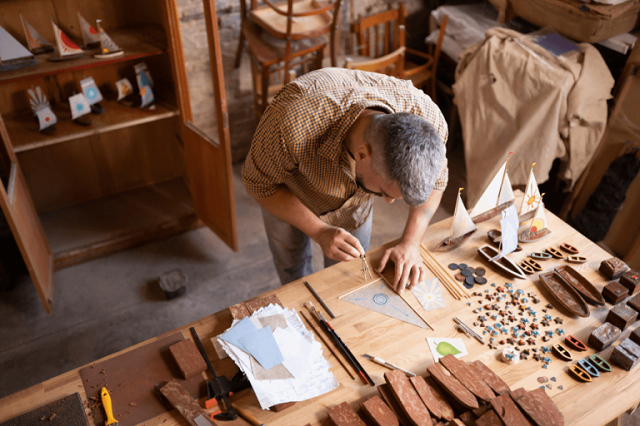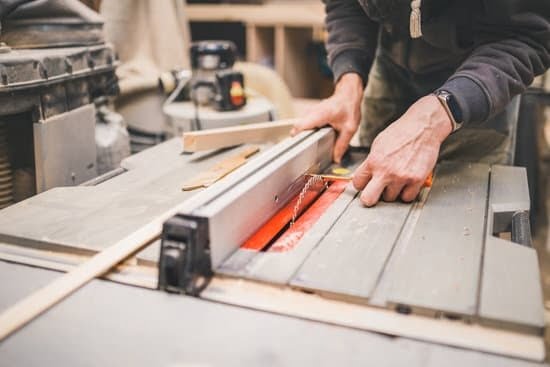Introduction
Woodwork is a creative and fulfilling hobby that can produce useful, beautiful, and memorable projects. It allows you to express yourself in ways not possible with any other activity, often bringing a sense of satisfaction of having created something with your own hands.
There are a variety of woodworking techniques available to those interested in this wonderful pursuit. Whether you are looking for an easy-to-learn beginner project or more advanced pieces requiring specialized tools and techniques, the possibilities are endless. You can create small or large pieces with ease such as garden beds, chairs, boxes and outdoor furniture using both hardwoods and softwoods. Whether you’re practicing basic cuts to perfect your technique or working on intricate designs, woodworking offers something for every skill level.
Another advantage of woodworking is that it does not require a lot of money to get started. A few simple tools such as a saw, hammer, screwdriver and drill are all that’s needed for basic projects like assembling a wooden box or building a wine rack. As your skills grow, more tools may be added including joiners and routers. With some practice and creative thinking there is no limit to what can be accomplished by someone turning wood into art!
Finally, woodworking also provides opportunities for connecting with other people who share similar interests while learning new construction skills together. Joining online forums or attending meetups can be great ways to enjoy getting advice from experienced professionals while sharing experiences (and stories) with likeminded people!
Essential Supplies and Tools for Woodworking
Woodworking as a hobby can be enjoyable and rewarding, but it requires the right supplies and tools to do it properly. Before starting any woodworking project, you will need certain materials and tools such as saws, hammers, chisels, mallets, screwdrivers, safety glasses, clamps, workbench planks, sawhorses and most importantly quality wood. Saw blades vary in size and shape so you must determine what type you need for your project. Hammer sizes are based on weight with larger ones used for heavier jobs while smaller ones are suitable for finer tasks like making joints between pieces of wood. Chisels come in a variety of sizes ranging from big to small; each used for particular tasks. Mallets are essential if you’re looking to shape or flatten wood without damaging its fibers. Screwdrivers come in various shapes including flat head and Phillips which can be used for assembling furniture pieces together. Safety glasses are an important piece of equipment as well because they protect your eyes from splinters of flying wood chips when using power tools. Finally comes the clamps which keep pieces of wood together firmly so that glue can effectively bond them together permanently. Having the right supplies is essential to any successful woodworking project so make sure not to skimp on quality materials or rush through the process!
Safety Tips and Protective Gear for Woodworking
Woodworking can be a dangerous activity if proper precautions are not taken. It is important to remember to wear safety glasses and a dust mask while working with power tools. Also, hearing protection should be worn when using noisy equipment such as saws, sanders, and routers. Further protective gear includes sturdy shoes or boots that provide support for the feet and legs, long-sleeved clothing, gloves, and an apron or shop coat.
Additionally, when collecting materials for woodworking projects, it’s important to make sure nails have been removed and boards are in good condition before beginning work on them. Using caution when handling sharp tools will reduce the risk of cutting oneself. Keep tools stored in safe areas with covers closed at all times”preferably on metal shelves above head level”and inspect all power cords before use. To lower the risk of fire hazards, always clean up any materials or dust which are spread around the workspace.
Beginner Woodworking Projects ” A Guide
Woodworking can be an enjoyable hobby for many people- it gives you the opportunity to explore your creative side with the creation of interesting and unique handmade items. However, getting started can be challenging if you don’t have a plan or clear direction. Therefore, it’s important to choose beginner woodworking projects that are easily achievable yet attractive and useful.
One great place to start is with a simple birdhouse project which can be completed with just a few basic tools such as saws, hammers, chisels and screws. If you want something more advanced, try creating a bookshelf out of scrap wood – this will take some skill and patience but is sure to look impressive when completed! Alternatively, you could try your hand at making a set of wooden frames for photos or pieces of art – all you need is some glue and paint.
If none of these projects appeal, then perhaps furniture building projects are more up your alley. Building furniture requires greater skill than the average beginner project but can give greater satisfaction when finished. Once you gain the skills needed to build furniture, you’ll be able to apply them to almost any kind of project – from chairs and tables to cabinets and desks! The possibilities are endless!
Of course there are plenty of easier beginner woodworking projects for those who just want to dip their toes in. These include smaller items like keychains or chopping boards which can be put together in just a few hours by someone who has little knowledge about woodworking tools or techniques. At the end of the day, there’s something suitable for everyone no matter their level of experience or knowledge!
Tips and Techniques for Finishing Off Your Woodworking Project
One of the best ways to learn and improve your woodworking skills is to get some practice. Working on small projects helps hone your craftsmanship, and finishing those projects in a timely and professional manner can help boost your confidence. Here are some tips and techniques to help you finish off your woodworking projects with a professional touch.
Firstly, once you have finished constructing the piece, use sandpaper or a power sander to smooth it down, paying extra attention to any corners or hard-to-reach areas. This will ensure that the surface is level and even before you add a finish. Secondly, prepare the wood by removing dirt, dust and grime first before applying wood conditioner or preservative, which will seal the grain in order to protect against moisture damage. If desired, finish with staining or varnish for protection against the elements as well as adding beauty and colour. Finally, use finishes such as waxes or oils over paint or stain for greater durability of your workpiece. These lubricants also create a protective film that allows for easier cleaning and maintenance without compromising the look of your project. With some practice and these tips in mind, you’ll soon be creating beautiful pieces through honed skillful craftsmanship!
Showcasing and Selling Your Woodworking Creations
Once you have become skilled in woodworking, you may be interested in displaying and selling your creations. One option is to join a local market or craft fair where artisans can gather and showcase their work. This will give you the chance not only to share your woodworking items with the public, but also to meet other woodworkers who can offer tips, advice, insight and support. If you are looking for buyers online, Etsy is an excellent place to set up shop as it’s widely used by artisan creators of all kinds. You may also consider setting up a website or blog of your own where people can browse your products and contact you directly with inquiries. Additionally, if you encounter enthusiastic responses from friends and family to the pieces that you make, don’t be afraid to use word-of-mouth marketing; they could turn out to be some of your best customers!
The Different Types of Woodworking Projects and Techniques You Can Try
Woodworking can be a highly rewarding hobby, and there are countless types of projects and techniques you can employ. From making furniture to wood carvings, woodworking provides a sense of accomplishment while also allowing you to display your creativity. Beginner-level woodwork projects such as cutting boards, shelves, birdhouses, or simple chairs are all great ways to get started on your woodworking journey. As you progress in your skills and gain experience, more complicated projects such as building a dining table or entertainment center become manageable. Various types of hand tools such as saws, chisels, planes, and rasps must be utilized for certain projects. Power tools like drills and routers can be used to quickly bore holes into the material or shape it according to your design specifications. Wood joints such as dovetails or mortise-and-tenon joints give otherwise basic pieces a professional touch that adds strength and stability. Finishing methods such painting, staining or varnishing will enhance the beauty of the piece and make it last generations. With the vast array of options available from what type of material to use and how it’s finished off, there’s an endless amount of creations that can be made when engaging in woodwork as a hobby!
Troubleshooting Common Problems You Might Encounter While Woodworking
One of the most common problems woodworkers might face is making poor cuts due to a dull blade. Regularly maintaining and sharpening your tools is important for the accuracy of any projects. Another frequent challenge is not planning ahead ” measuring twice, cutting once! Before you start a project, make sure to properly measure everything and create a detailed plan for even spacing, avoiding unsightly gaps or other errors. You may also encounter pieces that don’t fit together snugly due to shifts in tension or expansion resulting from environmental changes, like air temperature and humidity. To prevent this application of wood sealant might help ensure the wood stays sealed and maintains its shape long-term. Additionally, it’s important to know proper wood species selection. Different types of wood are better suited for different purposes (like outdoor furniture). Knowing which one works best can prevent further issues in the future. Lastly, dust build-up can be detrimental to your overall performance as well as your health. Investing in good protective gear, such as a dust mask should be taken seriously when working with materials that produce airborne particles.
FAQs About Woodworking As A Hobby
Q: What tools will I need to get started?
A: You will need basic tools such as a saw, hammer, drill, nuts and bolts and screws. You may also want additional items like clamps, files, chisels and other specialized cutting tools or router bits. In addition you may require sandpaper, spare blades, protective gear and sealant.
Q: Will I be able to create furniture?
A: Yes! With the right skills and tools you can make beautiful furniture such as tables, chairs and shelves for your home. Woodworking projects can range from simple frames to intricate cabinets. Moreover, some woodworkers even take on more challenging projects such as crafting musical instruments.
Q: Where can I learn how to do woodworking?
A: There are many resources available both online and offline where you can find out everything you need to know about woodworking as a hobby. From books on techniques to videos that show detailed step-by-step instructions ” there are plenty of learning resources available.
Conclusion
Woodworking as a hobby is an enjoyable way to spend your free time. Whether you are creating an intricate piece of furniture or something more basic, the completion of a successful project can be extremely satisfying. Not only does woodworking allow you to tap into your creative side, but it also provides the opportunity to develop skills you may have never thought possible. Along the way, many learn valuable lessons that help them become better workers and more knowledgeable individuals when they’re using tools or constructing any type of wood object. With each successful project comes the confidence that one day can conquer similar ambitious tasks in everyday life applications. Ultimately, woodworking as a hobby is an activity that provides great rewards for those willing to see their projects through from beginning to end.

Hi everyone! I’m a woodworker and blogger, and this is my woodworking blog. In my blog, I share tips and tricks for woodworkers of all skill levels, as well as project ideas that you can try yourself.





